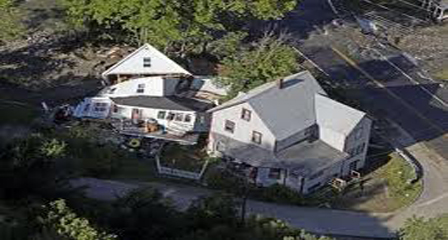MONTPELIER, Vt. — Flooding from Tropical Storm Irene swept away some bales of hay Doug Turner grew to feed his dairy cows and ripped open others, contaminating them with muddy water. When the water receded, he had to mow down a third of his corn, which had turned brown and moldy.
In most years, Turner grows all the hay and corn his 45 cows need, but like a number of Vermont farmers, he's struggling to find feed this winter after the August storm damaged a third of his crops. The timing of the destruction couldn't be worse. Feed prices have risen nationwide amid a hay shortage caused by drought in the Southwest.
Turner, 56, got 63 bales of hay from Maine for $40 each, including delivery. But he needs 75 to 100 bales more, and he expects it to cost more. If he can get the hay, he'll likely pay about $6,000 for feed this year — an expense he doesn't usually have.
"I've located some more (bales), but I also have to locate more money," Turner said.
Vermont has a long dairy farming history, although it has been losing small family farms in recent years because of low milk prices and high feed and fuel costs.
While the Aug. 28 storm flooded only 6,000 of the state's 92,000 acres of feed corn, the water was concentrated in certain areas, hitting farmers there hard. In some cases, the water flattened their plants. In others, silt left by the flood contaminated corn and the dampness fostered mold.
Many farmers are now scrambling to find feed, buying from friends who were luckier or looking to neighbor states. In a different year, they might get feed from New York or Pennsylvania, but those states also were hit by Irene and then by Tropical Storm Lee. There's grain in the Midwest, by the farther it's shipped, the more it costs.
Vermont Agriculture Secretary Chuck Ross said the feed shortage is adding to hardship already suffered in the storm that killed six and damaged more than 500 miles of roads, damaged or destroyed dozens of bridges and inundated several communities. Ross estimated in September that crop losses and damage to farms exceed $10 million. A final tally is still being determined.
"It's going to put them under strain," Ross said, referring to the farmers who need to find replacement feed. "I mean they're already under strain."
Most farmers will need feed until May or June, when cows can graze again. If they keep their cows in barns year-round, they'll need feed until next fall.
Even if farmers get all the feed they need, they aren't in the clear. The state has encouraged all of its 1,000 or so dairy farmers to test stored corn for micotoxins, which thrive in damp conditions. Micotoxins are molds that can make cows sick and one found in warmer climates is considered a carcinogen.
The University of Vermont Extension recently opened a testing lab to provide quick and free screening of feed.
"It's just that mold issue it's out there for many farms. Even if they didn't get inundated with Tropical Storm Irene it was wet," Deputy Agriculture Secretary Diane Bothfeld said.
Vermont farmers say they have been receiving help. Those who have hay and corn are sharing with those who don't. Offers of feed have come in from Canada, Maine and New Hampshire.
David Ainsworth, 57, of South Royalton, typically grows all the corn and hay for his 50 cows, but this year, he lost most of his corn. He bought eight acres worth of corn at a cost of $50 to $55 per ton, but then he got hay free from a neighbor.
"I'm hoping we're all set," he said. "We'll see, having never been through it before and hope to never have to again in my life."
The Perley Farm in Royalton lost about 30 of its 35 cows in the storm, along with 200 hay bales that were washed down the river. It has spent $12,000 replacing the hay, getting a reasonable price from nearby farmers who didn't need it. In turn, the farm shared some of its corn, planted on a hill, with a nearby farmer who lost his corn and was willing to cut Perley's.
Penny Severance, 48, who manages the dairy farm with her husband and son, worries about planting next year because fields are still covered in silt.
"We've got muck that we're having hard time trying to strip off, we're having a hard time moving it," she said, adding that next year, "I think that's when you're going to find there's big concerns for a shortage of feed."












0 komentar:
Post a Comment